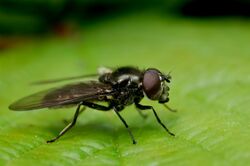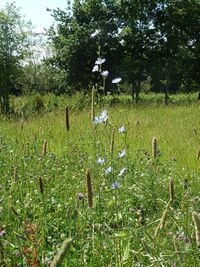Biology:Cheilosia variabilis
| Cheilosia variabilis | |
|---|---|

| |
| Male of Cheilosia variabilis. Dorsal view | |

| |
| Side view. Face showing projecting hairs on the sides | |
| Scientific classification | |
| Kingdom: | |
| Phylum: | |
| Class: | |
| Order: | |
| Family: | |
| Subfamily: | |
| Tribe: | |
| Genus: | |
| Species: | C. variabilis
|
| Binomial name | |
| Cheilosia variabilis (Panzer, 1798)
| |
| Synonyms | |
|
List
| |
Cheilosia variabilis, common name figwort cheilosia, is a species of hoverfly belonging to the family Syrphidae.[1]
Distribution
This species is native to the Palearctic realm, present in most of Europe eastwards to western Siberia, in the Near East, and in North Africa.[2][3]
Habitat
These hoverflies inhabit deciduous forest, from the Fagus, Picea zone to alluvial hardwood forest, tracksides and edges of clearings.[4]
Description
For terms see Morphology of Diptera
Cheilosia variabilis can reach a body length of 10–25 millimetres (0.39–0.98 in) and a wing length of 9–12 mm. Like most Cheilosia this large species is blackish, and because of this colour it may often be overlooked as a hoverfly. Face has outstanding hairs on the sides and a conspicuous central knob. Antennae are black or dark brown and hairs of arista are longer than diameter of basal part. Thorax is black-haired. Abdomen is rather elongate and tergites are pale yellow-haired. Wings are greyish and disproportionately long. Legs are entirely black. In males halteres are pale brown.[5]
[6]
[7][8] The larva is figured by Dusek (1962).[9]
This species is rather similar to Cheilosia lasiopa, Cheilosia vulpina and Cheilosia griseiventris.
File:Cheilosia variabilis - 2012-07-26.webm
Biology
Adult hoverflies can be found from April to September in two generations per year, as this species is bivoltine. They visit flowers of white umbellifers, Aegopodium podagraria, Alliaria petiolata, Anthriscus sylvestris, Apiaceae, Aurinia saxatilis, Conium maculatum, Crataegus laevigata, Euphorbia cyparissias, Meum athamanticum, Potentilla reptans, Ranunculus repens, Salix spec., Sambucus nigra, Caltha, Cirsium, Galium, Scrophularia, Sorbus aucuparia.[10]
The larvae are miners in the rhizomes of the common figwort (Scrophularia nodosa) (hence the common name) and in the stalks of the water figwort (Scrophularia auriculata).[11][12]
References
- ↑ Catalogue of life
- ↑ Fauna europaea
- ↑ Peck, L.V. (1988) Syrphidae. In: Soos, A. & Papp, L. (eds.) Catalogue of Palaearctic Diptera, 8: 11-230. Akad.Kiado, Budapest.
- ↑ Speight, M.C.D. (2011). "Species accounts of European Syrphidae (Diptera)". Syrph the Net, the Database of European Syrphidae 65: 285pp. http://www.diptera.info/downloads/StN_Species_Accounts_Glasgow_2011.pdf.
- ↑ Van Veen, M. (2004) Hoverflies of Northwest Europe: identification keys to the Syrphidae. 256pp. KNNV Publishing, Utrecht.addendum
- ↑ Van der Goot,V.S. (1981) De zweefvliegen van Noordwest - Europa en Europees Rusland, in het bijzonder van de Benelux. KNNV, Uitgave no.32: 275pp. Amsterdam.
- ↑ Bei-Bienko, G.Y. & Steyskal, G.C. (1988) Keys to the Insects of the European Part of the USSR, Volume V: Diptera and Siphonaptera, Part I. Amerind Publishing Co., New Delhi. ISBN:81-205-0080-6.
- ↑ Coe, R.L. (1953) Diptera: Syrphidae. Handbks.ident.Br.insects, 10(1): 1-98. R.ent.Soc.London. pdf
- ↑ Dusek, J. (1962) Beitrag zur kenntnis von larven der Gattung Cheilosia Mg. (Diptera, Syrphidae). Acta Soc.Ent.Cechoslov. 59(1): 68-72.
- ↑ de Buck, N. (1990) Bloembezoek en bestuivingsecologie van Zweefvliegen (Diptera, Syrphidae) in het bijzonder voor België. Doc.Trav. IRSNB, no.60, 1-167.
- ↑ BARKEMEYER, W (1994). "Untersuchung zum Vorkommen der Schwebfliegen in Niedersachsen und Bremen (Diptera: Syrphidae)". Naturschutz Landschattspfl. Niedersachs. (Hannover) 31: 1–514. ISBN 3-922321-70-4.
- ↑ Stubbs, Alan E.; Falk, Steven J. (1983). British Hoverflies: An Illustrated Identification Guide. British Entomological & Natural History Society. pp. 253, xvpp.
External links
- Boldy Systems
- Flickr Photos
- Stuart Ball, Roger Morris Britain's Hoverflies: A Field Guide - Revised and Updated Second Edition
Wikidata ☰ Q2747680 entry


